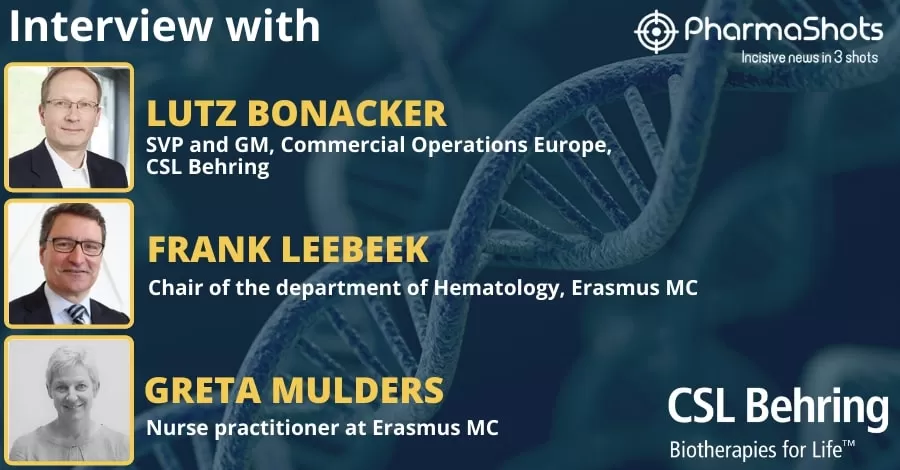PharmaShots Interview: Frank Leebeek & Greta Mulder of Erasmus MC, Lutz Bonacker of CSL Behring Share Insight on Etranacogene Dezaparvovec for the Treatment of Hemophilia B
In an interview with PharmaShots, Frank Leebeek, MD, Ph.D., Hematology Department Head & Greta Mulders, Nurse Practitioner, Study Coordinator at the Erasmus Medical Center in Rotterdam, Lutz Bonacker, Senior Vice President, General Manager, Commercial Operations Europe at CSL Behring shared their views on the data of Etranacogene Dezaparvovec in P-III (HOPE-B) trial for the treatment of Hemophilia B, presented at EAHAD 2022
Shots:
- The P-III (HOPE-B) trial evaluates the safety & efficacy of etranacogene dezaparvovec in 54 male patients with hemophilia B
- The results showed that patients experienced a stable & durable increase in mean FIX activity & hemostatic protection @18mos. at the single infusion of etranacogene dezaparvovec, 64% reduction in ABR for all bleeds & 77% in FIX-treated bleeds, 98% discontinued use of prophylaxis, 97% reduction in mean unadjusted annualized FIX consumption & was well-tolerated
- Etranacogene Dezaparvovec is an AAV5-based gene therapy. Additionally, preclinical/clinical data showed that the therapy may be clinically effective in ~95% of patients with pre-existing Abs to AAV vectors
Tuba: What can you tell me about hemophilia B and its epidemiology (global distribution, demographical distribution, etc.)?
Frank Leebeek: Hemophilia B is caused by a deficiency of coagulation Factor IX (FIX). It is a rare bleeding disorder that occurs in about 1 in 30,000 males.
Greta Mulders: Although it is passed from mothers to sons, about one-third of cases are caused by a spontaneous mutation, a change in a gene.
Frank Leebeek: Individuals with severe hemophilia have an increased bleeding tendency which may lead to recurrent joint and muscle bleeds and, if not treated adequately, will result in disability due to hemophilia arthropathy (joint disease). The current standard of care is to administer (recombinant) coagulation FIX intravenously to patients one to three times per week in order to prevent bleeding and long-term damage.
Tuba: Can you please tell me about the role of gene therapy in hemophilia B?
Frank Leebeek: Gene therapy can be used in patients with hemophilia B by introducing a wild-type or modified FIX gene – using an intravenously administered AAV vector – in the hepatocytes in the liver.
Greta Mulders: In this way, gene therapy can offer a potential “cure” for patients with hemophilia by establishing continuous endogenous expression of FIX following the transfer of a functional gene to replace the patient’s own defective gene.
Frank Leebeek: In several studies this has been shown to be very effective, resulting in long-term expression of FIX without the need for long-term prophylaxis, and reducing the bleeding phenotype.
Greta Mulders: Because patients no longer need prophylaxis, (except in cases of surgery or trauma), they are able to live a more “hemophilia-free” life.
Tuba: Tell me about the Phase 3 HOPE-B study
Frank Leebeek: The HOPE-B trial was a Phase 3 study using an AAV5-based FIX gene therapy in which a modified FIX gene was inserted in the expression cassette. This included the FIX Padua variant, which has a higher FIX-specific activity. Using the same amount of AAV vector as used in previous Phase 1-2 trials using a wild-type FIX gene, resulted in four to six times higher FIX activity in the blood of patients receiving the gene therapy.
Greta Mulders: An intensive follow-up was needed, which can be a burden for patients. During the first three months, checkups were needed every two weeks.
Tuba: What can you tell me about the key findings of Phase 3 HOPE-B study, recently presented at EAHAD 2022?
Frank Leebeek: At the EAHAD 2022 congress, Professor Wolfgang Miesbach presented data of more than 50 patients included in the Phase 3 study, 18 months after gene therapy infusion.
Greta Mulders: After the administration of gene therapy, study participants maintained stable FIX activity through 18 months.
Frank Leebeek: Mean FIX activity levels were 36.9 U/mL at 18 months and were comparable to data obtained after six months, which shows the sustainability of expression. Importantly, the data also showed a 64% reduction in annualized bleeding rate compared to regular prophylaxis during the lead-in phase.
Tuba: What is etranacogene dezaparvovec? Please can you tell me about it? Specifics around the mechanism of action, route of administration, formulation, and pathway would be appreciated?
Frank Leebeek: Etranacogene dezaparvovec is an AAV5-based vector containing a gene construct composed of a liver-specific promoter and a hyperactive FIX Padua mutant. This vector was developed using the AAV5 vector from a previously developed AMT-060 (Phase 1/2 study). Data from the AMT-060 trial are now available, covering more than four years, and show excellent efficacy and safety and stable expression of wild type FIX at 4.5-5 years of follow-up. The AAV5 vector is delivered once intravenously over 60 minutes.
Tuba: There are other approved drugs for hemophilia B. How are gene therapy and etranacogene dezaparvovec different?
Frank Leebeek: The current treatment for patients with severe hemophilia consists of regular intravenous administration of recombinant FIX concentrates. For several years, long-acting FIX concentrates have also been available, which has reduced the infusion frequency to once weekly or even once every two weeks. Gene therapy consists of a single infusion with long-term effects. For the patients participating in the HOPE-B trial who were treated in our center, gene therapy has changed their lives. From previously needing twice-weekly intravenous prophylaxis before gene therapy, they have now needed no treatment for hemophilia for 18 months.
Greta Mulders: Studies show that most patients with hemophilia have a positive attitude towards gene therapy and that, besides efficacy, safety, and the related uncertainties, the impact on daily life is also important to patients. The potential of gene therapy is definitely life-changing and must be carefully guided by healthcare professionals. The impact of treatment on mental health is being studied in several ongoing trials.
Tuba: There are also gene therapies in development for hemophilia A. How is the approach and trial results we’re seeing so far different between hemophilia A and hemophilia B?
Frank Leebeek: For hemophilia A, several gene therapy trials are ongoing with impressive results. The FVIII levels obtained using gene therapy for hemophilia A are higher (even up to 100% after six months in a Phase 3 study), however, these levels decreased over time. This is different from hemophilia B where data show sustained expression for over eight years. Another problem that seems to occur more often with hemophilia A gene therapy is long-term liver function abnormalities, for which the exact cause is yet unknown.
Greta Mulders: The liver function abnormalities and the use of immune suppression in the long term can cause worries for patients. Like patients who undergo gene therapy for hemophilia B; supporting patients in gaining trust in their new phenotype is of upmost importance.
Tuba: What is your next move and when are you planning to commercialize etranacogene dezaparvovec?
Lutz Bonacker: As a global leader in the treatment of hemophilia and a partner to the hemophilia B community, CSL Behring is proud of its well-established history of developing and delivering plasma-derived factor replacement and recombinant long-acting treatments. However, we understand there remains a significant unmet need for many hemophilia B patients. As part of Our Promise, CSL Behring is committed to delivering new, ground-breaking solutions for people living with hemophilia B.
With etranacogene dezaparvovec, we have an opportunity to introduce the next wave of breakthrough medicine and transform the treatment paradigm for people living with hemophilia B. A single dose of etranacogene dezaparvovec produced Factor IX levels in a near-normal range that remained stable and consistent over the course of the study, while also significantly reducing the rate of annual bleeds. 98 percent of patients treated with a full dose of etranacogene dezaparvovec discontinued the prophylaxis by coagulation Factor IX regular intravenous infusions.
As disclosed in December 2021 the EMA’s Committee for Medicinal Products for Human Use (CHMP) granted CSL Behring an accelerated assessment for its Marketing Authorization Application (MAA). Accelerated assessment is granted to products determined to be of major interest for public health and therapeutic innovation and potentially reduces the EMA review timeline from 210 days to 150 days once the MAA is filed and validated.
While we cannot speculate about the specific timing of a potential approval, CSL Behring will continue working with governments, policymakers, and other stakeholders to help appropriate hemophilia B patients access this transformative therapy.
Tuba: In which geographic locations will the drug first be available?
Lutz Bonacker: At present, we are focused on understanding and meeting the regulatory requirements for approval in the EU and US.
While we continue through the regulatory process, we are also working diligently to expand potential access for appropriate people living with hemophilia B. Just as gene therapies are shifting treatment paradigms for people living with rare and serious diseases, the reimbursement paradigms need to shift from a chronic care model to a curative model. By improving access, policymakers can empower physicians and patients to determine the most appropriate therapy, whether that be gene therapy or prophylaxis, based on clinical criteria and individual needs.
To best support appropriate people living with hemophilia B, it is imperative that health systems and policymakers recognize the unique value gene therapy provides and develop value assessment methodologies that appropriately capture the potential benefits of gene therapy.
As a company at the forefront of this shift, CSL Behring is working with health systems and policymakers to acknowledge the limitations and burdens of certain prophylactic therapies, recognize the unique potential of gene therapy to address unmet medical needs, and identify assessment methodologies to appropriately capture the benefits of gene therapy.
Tuba: Are you looking for any collaboration to commercialize etranacogene dezaparvovec?
Lutz Bonacker: No. In May 2021, CSL Behring closed a licensing agreement with uniQure for the global development and commercialization of etranacogene dezaparvovec.
CSL Behring is committed to accelerating patient access to gene therapy and will work with all stakeholders, including the medical and patient community, to find the best solutions to ensure quick access and adequate healthcare delivery to patients who can benefit from this life-changing and transformative innovation.
Tuba: Please can you tell me more about the CSL Behring pipeline?
Lutz Bonacker: Etranacogene dezaparvovec complements CSL Behring’s robust hematology product portfolio and builds on its strong legacy and commitment to delivering innovative solutions to enhance care and outcomes for people living with these rare and serious diseases.
Our R&D portfolio includes candidates of various stages, from research to registration, across therapy areas including immunology, vaccines, hematology, respiratory, transplant, and cardiovascular and metabolic.
Source: MS International Federation
About Author:

Frank Leebeek, Hematology Department Head at the Erasmus Medical Center in Rotterdam. He obtained his medical & Ph.D. degree in clinical studies on fibrinolysis inhibitors synthesized by the liver at the Erasmus University in Rotterdam. He subsequently worked as a post-doctoral fellow for two years at the University of North Carolina at Chapel Hill, USA

Lutz Bonacker is Senior Vice President and General Manager, Commercial Operations Europe at CSL Behring. He received his Doctor of Philosophy at Max Planck Institute for Terrestrial Microbiology

Greta Mulders is a Nurse Practitioner and Study Coordinator at Erasmus MC and Secretary of the EAHAD Nurses Committee. In 2010, she received her master’s in Advanced Nursing Practice. Greta is a board member of the Dutch Association of Haemophilia Nurses and a member of the Advanced Nursing forum of the Erasmus Medical Center



